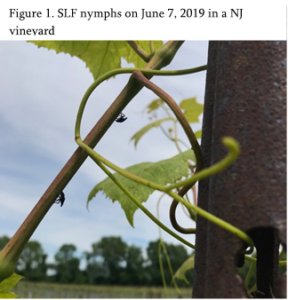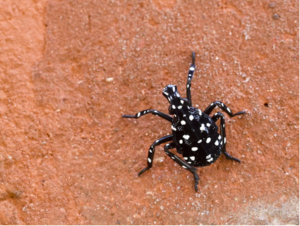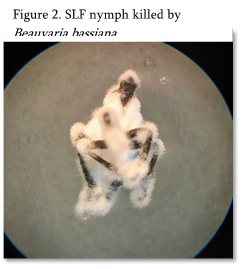Rutgers NJAES Wine Grape Extension, in association with Penn State Extension Grape and Wine Team, is calling on those who own, operate, or manage a farm or vineyard in the New Jersey region to participate in a survey that aims to track the spread and severity of nymph and adult spotted lanternfly populations during the 2023 season. The data collected will provide insights into the distribution patterns of both nymph and adult SLF within and outside vineyards, enabling growers and researchers to better understand this invasive pest’s potential impact on agriculture in the Mid-Atlantic region. [Read more…]
Spotted Lantern Fly (SLF) in the NJ Vineyards – Survey
Dear Vineyard operator,
Rutgers Cooperative Extension in collaboration with NJ Center for Wine Research and Education (NJCWRE) is seeking your response regarding Spotted Lantern Fly (SLF) infestation and losses in your vineyard in previous years. Your responses are critical to understanding the distribution and impact of this invasive pest in New Jersey. If you are unfamiliar with the spotted lanternfly or want to learn more about it, click here (https://njaes.rutgers.edu/spotted-lanternfly/). Please use the below link to fill out your responses.
The Survey Link: https://rutgers.ca1.qualtrics.com/jfe/form/SV_0OCjMZlaqXrOd6u
2021 Grape Expectation – Registration for Pesticide Recertification Credits
GRAPE EXPECTATION – 2021
New Jersey Wine Grape Symposium
March 6 (Saturday) 9 AM – 12 PM
Please note that, there is a two step process to register for the pesticide recertification credits. Please see below the links and instructions. If you have already completed the STEP 1 (registering for the educational sessions), you may skip that step and go the STEP 2. Program agenda is below the registration information. Pesticide credits approved are: 1A (4); PP2 (4); 3A(1); 6B(1); 8C(1); 10(3). [Read more…]
Help, Spotted Lanternfly Nymphs are in my Vineyard!
Management of Spotted Lanternfly Nymphs in New Jersey Vineyards
Megan Muehlbauer and Anne L. Nielsen
Vineyards in Salem and Hunterdon Counties in New Jersey are beginning to report spotted lanternfly (SLF) nymph sightings (Figure 1). These small black nymphs have white dots on their abdomens and will hop if disturbed. Although it is concerning to find them in large numbers in vineyards, we are not recommending that grape growers spray insecticides at the nymph stage.


(Photo Credit: https://www.pottsmerc.com)
Why? Thus far, there has been no definitive research showing that young SLF nymphs cause damage to grapes. If SLF is feeding on grapes during the 1st and 2nd instar (nymph) stages, they are likely feeding on the fleshly new growth, not on the canes or cordon as the adults do.
However, these nymphs are also likely representing a very low number of the total population of SLF in and around the vineyard they are being seen at, because research has also shown that nymphs feed on multiple host plants. To further elucidate details of SLF life cycle, and feeding habits, we are surveying to determine which life stages are found in commercial vineyards throughout the growing season.
As you make a decision on whether to spray the nymphs in your vineyard, It is important to keep these two points in mind.
1) Do not overuse pyrethroids in a vineyard as they can flare mealybug populations which vector leaf roll virus.
2) Save highly effective insecticides with good residual (Brigade, Actara, Scorpion, Carbaryl, and Mustang Maxx) for use against the adults in late summer through harvest.
If you want a material to apply now while the nymphs are just becoming active in the vineyard, the biological pesticides, BoteGHA (1-2 qt/acre) or BotaniGard 22 WP (0.5- 2 lbs/acre), are effective against the nymphs and will minimally impact other pests. These products have Beauvaria bassiana, a beneficial fungus that attacks insects and has good efficacy against SLF nymphs and a 4 hour REI. Keep in mind when using B. bassiana materials, they take a few days to kill SLF and the fungal growth will turn the nymphs into fuzzy white cotton balls (Fig 2). As a biological material they work best under humid conditions. Recommendations tank mix compatibility for BoteGHA can be found here

There are two other pests in NJ vineyards, grape berry moth and Japanese beetles, that commonly require management in the early summer. While there is no action threshold for SLF nymphs in the vineyard, management can be combined with existing pest management programs. Grape berry moth timing is approaching and we recommend using an insecticide that is effective against both SLF nymphs and grape berry moth if you have SLF nymphs in your vineyard (Table 1).
Just remember that the degree-day timing for grape berry moth is based on using growth regulators or diamide chemistries and application of a broad-spectrum material would be applied 1-2 days after the predicted timing. Japanese beetles typically occur in late June/July and again, there are insecticide materials that are effective against both SLF nymphs and Japanese beetle (Table 1).
Table 1. Insecticide efficacy against SLF nymphs and key grape pests
| Rating of Insecticide Efficacy* | |||
| Insecticide | SLF Nymph ** | Grape Berry Moth | Japanese Beetle |
| Avaunt 30SG | E | G | G |
| Brigade 10WSB | E | E | – |
| Entrust 2SC | F | G | – |
| Imidan 70WP | E | G | – |
| Carbaryl | E | G | G |
| Actara 25 WG | E | – | G |
*E – Excellent; G – Good; F – Fair; ‘-‘ not rated
**H Leach, DJ Biddinger, G Krawczyk, E Smyers, JM Urban 2019 “Evaluation of insecticides for control of the spotted lanternfly, Lycorma delicatula, (Hemiptera: Fulgoridae), a new pest of fruit in the Northeastern U.S.” Crop Protection 124:104833
The recommendations for spotted lanternfly control are centered around the adult stage which are considered the primary damaging stage. If adults are found in your vineyard they likely warrant management. In 2019 we saw SLF move into Northern NJ vineyards in large numbers at the end of September. It is important to note that they do not discriminate between vines that have been harvested or not. The only available threshold for SLF in grapes is 10 adults/vine, however this is quickly exceeded in some vineyards. We are recommending that growers apply a border spray targeting the vines on the borders or the first few panels if rows are perpendicular around your vineyard, with a focus on areas near hedgerows as it has been shown that those are the areas that SLF if most likely to congregate in at higher densities. Further information on adult SLF control, recommended insecticides and rates will be in a forthcoming Plant and Pest Advisory Post.
NJ Statewide Wine Grape Twilight Meeting (online)
Please join the NJ Statewide Wine Grape Twilight Meeting on the Wed, May 20, 2020 4:20 pm using the below link. Also, please see below for the program details.
Meeting Host: Hemant Gohil
https://rutgers.webex.com/rutgers/j.php?MTID=mbdbb2eafedfe9d44f3694adeedf61269
Meeting number: 222 571 928:
Password: MJht93B8Pzx
Join by phone +1-650-429-3300
Access code: 222 571 928 [Read more…]
South Jersey Tree Fruit Twilight Meeting – I
When: March 27 @ 7 PM
Where: Gloucester County Extension Office, 1200 N. Delsea Drive, Bldg. # A, Clayton, NJ 08312
7:00 PM: Welcome Remarks and Updates.
Hemant Gohil, Gloucester County Agricultural Agent, Rutgers NJAES
Comprehensive Understanding of Spotted Lantern Fly in Orchard Crops
Heather Leach, Spotted Lantern Fly Extension Associate, Penn State University. Invited Speaker, Heather leach is specialist on Spotted Lanternfly (SLF). She will speak on the comprehensive understanding of SLF priorities from every perspective and provide latest information on biology, behavior and effective management techniques.
Pesticide Record Keeping Update.
George Hamilton, Extension Specialist in Pest Management, Rutgers NJAES
Food Safety Issues Related to Tree Fruit Production.
Wes Kline, Cumberland County Agriculture Agent, Rutgers NJAES
Management of Scale Insect in Peach
Anne Nielsen, Extension Specialist, Fruit Entomology, Rutgers NJAES
Early Season Disease Control
Norman Lalancette, Extension Specialist, Tree Fruit Pathology, Rutgers NJAES
Scouting Observations and IPM of Early Season Pests
Dave Schmitt and Dean Polk, State-wide Fruit IPM Agent, Rutgers NJAES
9:30 PM Pesticide re-certification credits application and Adjourn
Light fare will be provided. Please call Joan Medany jmedany@co.gloucester.nj.us or call 856-224-8030 if you are planning to attend.
This site is accessible to the physically impaired. If an additional assistance is needed, please contact Hemant Gohil (Program Organizer) at 856-224-8029 prior to the meeting.
